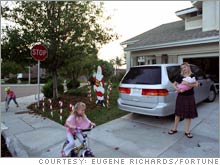 |
 |
| Kacey Olson, holding baby Allyson and watching daughter Ashlyn and friend. She and husband Andy refuse to overpay for a home. |
|
|
|
|
|
NEW YORK (FORTUNE) -
The story of Andy and Kacey Olson is a familiar one. They moved to The Woodlands, Texas, in 1998 to be close to the biotech firm Andy worked for, and they budgeted $750 a month for rent.
Before signing a lease, though, they wanted to see if they could buy for the same monthly payment. After doing the math on a small townhouse, it turned out they could -- so they bought and built equity for themselves instead of someone else.
Four months ago the Olsons and their four children moved to San Diego, where Andy had accepted a new position at a small biotech called GeneOhm Sciences.
They had $60,000 saved for a down payment. But when they toured one $750,000 home, they couldn't believe how small and unappealing it was.
"Everyone told us to just get in and the rising market would take care of us," Andy says. "But I thought, who is going to buy this house from me for $850,000?"
Once again they crunched a few numbers. This time they decided to rent -- and they're saving a bundle. For $2,350 a month, they have a four- bedroom, 2,100-square-foot home. If they were to purchase that same home today for $700,000 (the going rate for a similar house in the neighborhood), the monthly payment on a 30-year, $630,000 mortgage at 6.1 percent would run them more than $3,800.
The rental market, in fact, can be an excellent tool for gauging the health (and risk) in a local market -- particularly in cities where home prices have risen much faster than rents.
Some experts look at the ratio of home price to rental income as a valuation tool, like the P/E for stocks. The statistics highlight some potential trouble spots.
In New York, for instance, house prices have climbed to 24 times rental rates, up from 12 in the mid-1990s, according to calculations by Mike Sklarz, a real estate analyst with title insurer Fidelity National Financial.
In Los Angeles the ratio has grown to 20, up from 10.
And in San Diego, where the Olsons live, the ratio now stands at 27, compared with 13 ten years ago.
The Olsons are already glad they didn't jump in. They've noticed that houses in their neighborhood are staying on the market longer, and they've seen asking prices in real estate circulars come down.
Come spring, they say, they might try to make a few low-ball offers to see what comes of them. "We'd rather be homeowners," says Kacey. "But we'll rent for as long as it makes sense financially."
_______________
More questions:
Is it time to cash out?
Should you rethink your mortgage?
How valuable is your equity?
Plus: Exclusive forecast for 100 markets

|